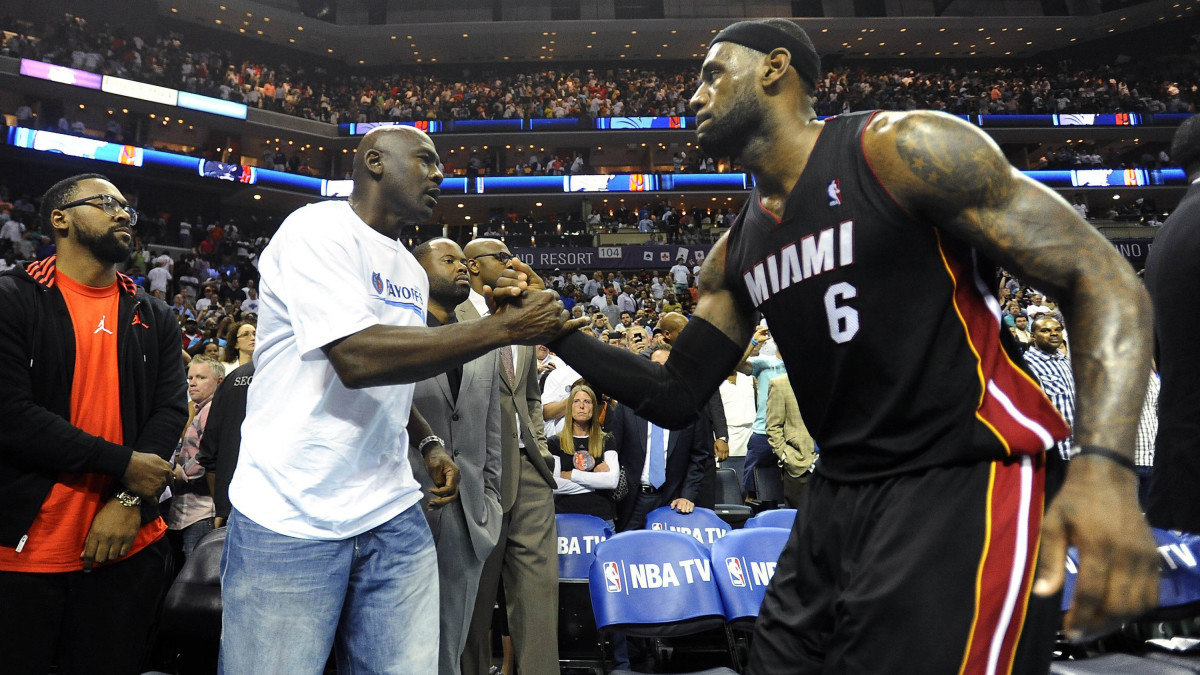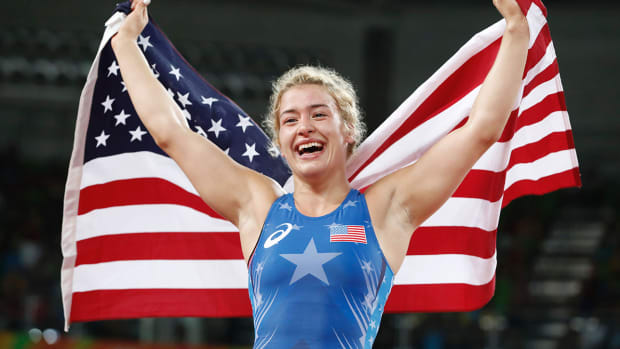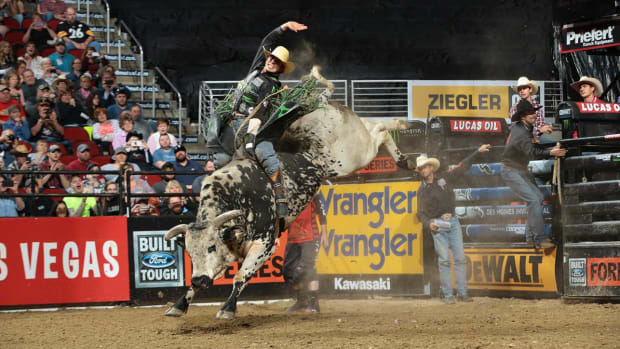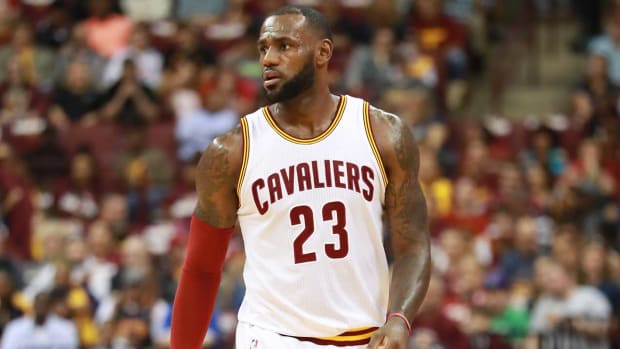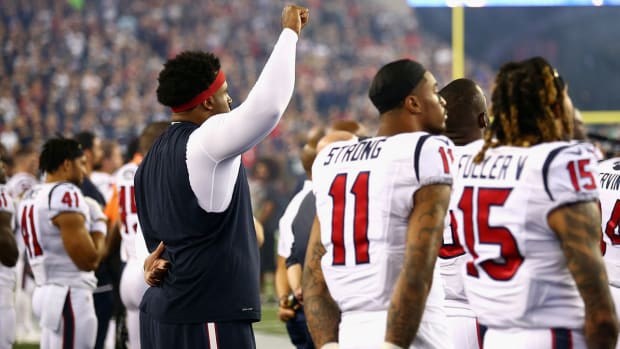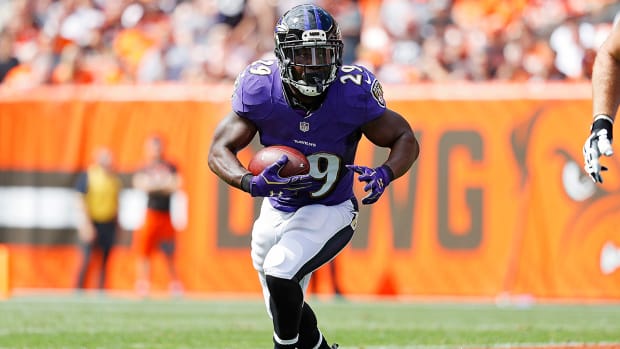To become the NBA's GOAT, LeBron needs a little help from his friends
Michael Jordan is the standard by which all NBA wings are measured. The comparisons remain inescapable, particularly when it comes to Kobe Bryant and LeBron James, the two players who have offered the strongest contemporary challenges to Jordan’s legacy as the league’s undisputed greatest of all time.
The discussion is, as you’d expect concerning players whose primes didn’t (really) intersect, rife with hypotheticals and caveats. Just a few weeks ago, Jordan and LeBron engaged in a much-ballyhooed back and forth over who would win a one-on-one contest in their respective primes. We'll obviously never know, so things inevitably always seem to circle back to “RINGZ,” the default currency in any "legitimate" discussion about who is the NBA's G.O.A.T. Jordan, of course, has six of them—one for every trip he ever made to the NBA Finals. Kobe boasts five, and could have tacked on two more were it not for the egalitarian might of the 2004 Detroit Pistons and the sheer veteran intensity of the Kevin Garnett-led 2008 Boston Celtics.
Then there’s King James, who for all his considerable and often-Herculean efforts (he’s made five consecutive NBA Finals, and six in total), has "only" hoisted the Larry O'Brien Trophy twice.
SI.com's Top 100 NBA Players of 2016
Winning an NBA Championship requires more than superlative individual performance, though. To outlast the opposition, especially in today’s NBA, you also need a deep and versatile bench—a point that was hammered home again during the 2015 Finals, when LeBron’s superhuman outings simply weren’t enough to carry his injury-ravaged team past the mighty Golden State Warriors.
So, in order to more accurately judge this all-time trio of Hall of Fame talent, we need to dig a bit deeper, and once you separate individual performance from the quality of the supporting casts, the gap between LeBron’s two titles and Kobe’s and Jordan’s combined 11 isn’t nearly as vast as it might appear.
Box Plus-Minus, a box-score amalgamation of a player’s net impact per 100 possessions, is one way to measure overall individual production. By this metric, the arc of LeBron’s career is virtually incomparable—he’s been better than Kobe at any stage of the latter's career, with peaks that are every bit as impressive as Jordan’s.
• MORE NBA: James summons teammates to workouts
If we focus only on the years in which each player made the NBA Finals, the edge trends dramatically in LeBron’s favor. During those seasons, James was worth 9.3 points more per 100 possessions than the average player (Jordan comes in at 8.1; Kobe at 4.7). It’s also interesting to note that both Jordan and LeBron failed to make the Finals in three of their four most productive seasons—the reason being the same as why Kobe has five rings despite considerably lower individual production: Context matters.
These three paramount players (have) spent their respective careers in dramatically different scenarios. Kobe was selected at the end of the 1996 lottery by the Hornets and immediately traded to the Lakers, arriving in L.A. the same summer as Shaquille O’Neal, one of the league’s greatest centers, who just happened to be entering his prime. As such, Kobe had the unique benefit of blossoming on a team with a Hall of Fame anchor already in tow.
LeBron and Jordan, on the other hand, were the prizes of their respective drafts (Sam Bowie, who?), and joined perennially struggling franchises that were devoid of upper-echelon pieces. While each would eventually enjoy the fruits of many a talented teammate over the years, neither had the kind of off-the-bat stability that teenage Kobe had.
The graph below uses a minute-weighted Box Plus-Minus average of each player’s teammates to measure the quality of their supporting cast for each season. Another way to read the chart is as an estimate of each team’s point differential had LeBron, Jordan, or Kobe’s minutes gone to a statistically average replacement.
• MORE NBA: Lakers fail in 2015 NBA off-season
Here we get a much clearer sense of the quality of those early Lakers teams—and the near-ideal situation in which an 18-year-old Kobe found himself. Both Jordan and James had to wait patiently as their rosters were slowly (and not always properly) built around them. Even then, MJ eventually ended up with much stronger supporting casts, on the whole, than LeBron.
The arc of Jordan’s career is pretty distinctive, with the supporting cast, stats, and championships all finding a logical nexus. If we compare supporting casts in seasons with Finals appearances, year by year, Jordan indeed had a lot of help. But he’s not the only one.
The Win-Loss Equivalent column—what that team would be projected to win across an 82-game season with an average player replacing all of Jordan, LeBron or Kobe’s minutes—is meant to make the supporting cast quality more accessible. Within this trio, the top nine supporting casts for a Finals appearance belong to either Kobe or Jordan. LeBron, meanwhile, tallied five of the bottom six on the combined list, including the only three teams projected to have a record below .500 without their star wing.
You can argue all you want about which player is the best, but this makes the strongest statistical case yet for LeBron not having had anywhere near the level of help Kobe or Jordan enjoyed. If we take the average of all Finals appearances for each player, we see essentially the same pattern.
Moving away from the Finals and looking at the entirety of each player’s career doesn’t really change things at all.
Obsessing over tenths of points per 100 possessions may seem like splitting hairs, but as the pyramid narrows and teams push towards a championship, margins for error shrink, and all of those tiny advantages take on greater and greater importance. The difference between a young Shaq, a hyper-versatile Scottie Pippen, and a worn-down Dwayne Wade are significant, and ought to be considered in any conversation about the trio’s relevant bona fides.
As a means of measuring the quality of a team’s supporting cast, Box Plus-Minus isn’t perfect. It is, after all, a closed system, meaning each point LeBron scores or rebound he grabs (thus increasing his BPM) is one less point or rebound that Kyrie Irving or Kevin Love could garner to increase theirs. At the same time, any argument that LeBron has somehow systematically made his teammates perform worse than their true talent levels sounds—and very much is—patently ludicrous.
FiveThirtyEight’s Neil Paine conducted a similar analysis during LeBron’s gargantuan Finals performance, using a multiyear statistical plus-minus model to mitigate some of those effects. Although his piece was specifically comparing LeBron’s supporting casts to one another, the overall results were strikingly similar. To wit: LeBron had three of the eight worst NBA Finals supporting casts since 1985.
Roundtable: Which NBA star would make the best late-night TV host?
Some might look at LeBron's Heat tenure as pointing to a unit that was intentionally unbalanced. The coalescing of that Big Three was, after all, an enormous financial investment, one that required foregoing much in the way of ancillary support. However, the issues here were more about the physical fragility and decline of Wade and Bosh than the players around them. In the four years before they teamed with LeBron, Wade had a BPM of 8.3; Bosh, 2.7. During their four seasons together, Wade wound up at 4.7, and Bosh at 0.6.
That's not to say the Heat failed at stocking their roster with respectable veterans. Rather, it was the decline of an injury-nagged Wade, combined with Bosh's restricted offensive role, that rendered Miami's Big Three less of a unstoppable force than many believed they'd be.
Jordan’s supporting cast for his six NBA Finals teams yielded an average impact of +4.3 points per 100 possessions. (This is much higher than what I found, in part because Paine only weighted with minutes played during the playoffs through the Conference Finals.) LeBron’s, meanwhile, came in at +2.1. Because Paine’s statistical plus-minus model considered Shaq to be the Lakers’ best player during their first three Finals appearances, I wasn’t able to fully calculate Kobe’s, but just looking at 2004 and 2008–2010, Kobe’s supporting casts averaged a net impact of +4.1.
Again, this it not to argue that LeBron is better than either Bryant or Jordan. But even given the chicken-egg nature of box score-based metrics, the numbers scream pretty loudly that LeBron has been more productive than either Kobe or MJ, and has done so with significantly less help from his supporting cast. As such, anyone seeking to end the G.O.A.T. argument at “RINGZ” at least would be wise to consider how LeBron might’ve fared had he entered those four other Finals with more firepower at his side.
